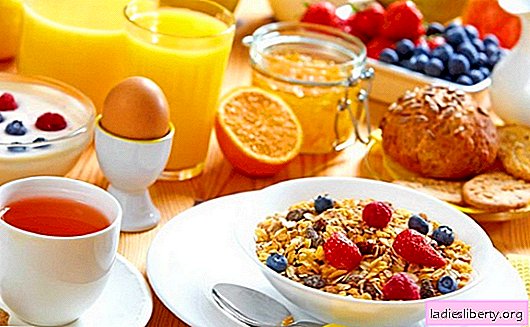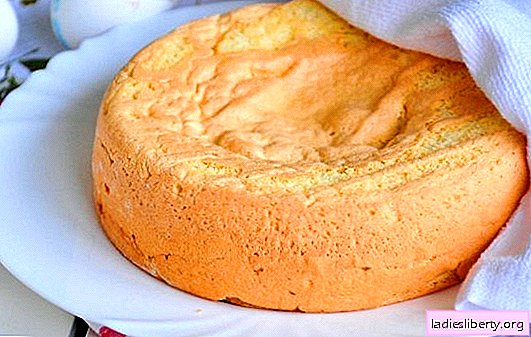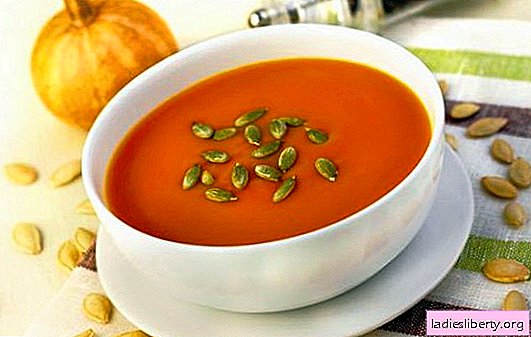
Nutrition is called nutrition, which is assigned to a child upon reaching a certain age and physiological parameters. It complements breast milk or milk formula, the nutritional value of which can no longer satisfy the needs of a growing organism. Thanks to complementary foods, when a baby eats a relatively small amount of food, he receives a lot of energy and nutrients in the form of proteins, fats and carbohydrates. Since in the first year of a baby’s life, the foundations of his future child’s health are laid, proper nutrition, including complementary foods, play a very important role.
The first lure - when and how to introduce
The question of when to introduce complementary foods excites all mothers. However, the answer to this question is clearly impossible. It is important to understand that the indicator of the baby’s readiness for feeding is not only age, but a number of parameters of his growth and development, including:
- type of feeding the baby (breast or artificial);
- the weight of the baby, which should be at least two times its birth weight (in premature babies - 2.5 times);
- the baby’s lack of a pushing tongue reflex (that is, if he is offered to drink in a spoon, he will be able to drink it, and not smear it on his chin). This is important, since complementary foods should be given only from a spoon so that it is processed with saliva for complete digestion.
- the child’s ability to sit, tilt the body to a spoon (indicating a desire to eat) or lean back (refusing food);
- the presence of a baby’s hunger after feeding her mother’s mixture or milk, even from both breasts;
- He has a great interest in the food that his parents eat, and a desire to try it.
In each child, all factors are fully manifested at different ages. As practice shows, most often the introduction of complementary foods to the baby occurs between the ages of 5 months and 9 months. When breastfeeding, the opinion of pediatricians about the introduction of the first feeding is unambiguous - this should not be done, the baby up to 6 months only needs breast milk. For children who are on artificial feeding, an earlier feeding is provided.
Mom should remember the main thing - it is better to be a little late with lure than to hurry. For example, complementary foods at 3 months can cause adverse reactions from the body of a child who is physiologically not yet ready to accept new food. These reactions can be manifested by abdominal pain, intestinal colic, regurgitation, vomiting, and stool disorders. Early feeding can cause a serious breakdown of the digestive system, requiring a long treatment. Another complication of thoughtless early feeding can be an allergy, which is caused by the high permeability of the intestinal wall for large molecules and the immaturity of the digestive enzymes and the immune system. In this case, the baby’s emerging immune system can be severely affected, which can lead to frequent infections and various chronic diseases.
If complementary foods are introduced to a child who has not matured mechanisms of swallowing thick foods, there is a danger that he may choke, begin to vomit and generally lose interest in food. Subsequently, due to the load that will be experienced due to the early introduction of complementary foods, unformed children's liver, kidneys and gastrointestinal system, these organs will be very vulnerable.
Another negative result of the early introduction of complementary foods is a decrease in breastfeeding, as a result of which lactation may decrease in mom. That is why the first feeding should be introduced only at a favorable time for this and only after consultation with the pediatrician who is observing the baby.
Feeding in 3 months
As we have already said, by the age of 3 months, enzymes are already ripening in the baby’s digestive system, the permeability of the intestinal mucosa is reduced, its normal immunity and mechanisms are formed that allow you to take semi-liquid and solid food. However, at this age, complementary foods should be treated with extreme caution. For children who are breastfeeding, its introduction is not recommended. The issue of complementary foods for babies that are fed with the mixture should be decided only at this age by the pediatrician.
Nutrient at 4 months
The babies that the mother is breastfeeding still do not need to be fed, receiving all the necessary nutrients from their mother’s milk. Although at this time the body is already preparing for a meal other than breast milk and milk formula. Children who are breast-fed can, with the permission of the doctor, start giving fruit juices, and they must always be one-component. It is better if it is a few drops of the usual apple juice for all of us.
Then, after observing the reaction of the child and not noticing any disturbing manifestations in the form of skin rash, intestinal colic, upset stool, you can begin to gradually increase the amount of juice by a few drops per day.
At the beginning, the easiest way to get juice is by rubbing an apple on a fine grater and squeezing a few drops of juice into a teaspoon from the resulting mass through a sterile bandage. It is important to remember that you can not introduce complementary foods with a bottle with a pacifier. You should feed the baby with a spoon, and later - use a drinking mug.
Nutrition in 5 months
At the 5th month, babies who are breast-fed can be given vegetable purees in the diet, starting with 5-10 grams and bringing their daily amount in the children's diet to 100 grams.
Nutrition at 6 months
At 6 months, most babies should already be given complementary foods in the form of mashed vegetables (weakened children can begin to be fed with cereals). The best vegetables for the first feeding are zucchini or cauliflower, but it is better to be careful with carrots, as it can cause allergies. In vegetable puree, you can add a few drops of vegetable oil. Gradually increasing the portion of complementary foods in the form of mashed vegetables, one should completely replace them with one milk feeding. By 10 months, the baby should eat up to 200 gr. mashed vegetables at one time.
Nutrient at 7 months
A baby of 7 months of age can safely be fed with porridge. In the first week, porridge should be liquid, prepared from 100 ml of water and 1 teaspoon of cereal. Then you can start to make it thicker and prepare from 100 ml of water and 2 teaspoons of cereal. A baby at this age can be fed rice, buckwheat or corn porridge made from cereals, previously crushed in a coffee grinder. The porridge is boiled in a small amount of water, and then diluted with breast milk or a mixture diluted to the desired consistency (but not cow's milk, which is a strong allergen). In the early days, you can give only a few teaspoons of porridge, then gradually bring its amount to 150 g. in a day. Such a portion of porridge can fully replace one breastfeeding or mixture. If a young mother does not have enough time or skill to make such a porridge, you can use ready-made cereals, the choice of which is very great today. When preparing them, be sure to follow the instructions.
In addition, the diet of a baby at this age can be supplemented with a yolk of a hard-boiled egg, chicken or quail. The first portion should be no more than a match head, then it can be brought to half a teaspoon.
Nutrient at 8 months
An 8-month-old baby should already be offered dairy products that are very useful for regulating his digestion and strengthening immunity, as well as fruit purees. At this time, the menu of the peanut can be supplemented with cottage cheese, kefir and yogurt. The purchase of these products should be made in the departments of baby food or prepared by the mother on her own. At 7 months, the baby can receive 1 teaspoon of cottage cheese and 30 ml of yogurt and kefir. A healthy child can eat 50 grams a year. cottage cheese and 100 ml of fermented milk drinks. Fruit purees should be started with 1 teaspoon. Then, daily increasing the portion, it must be brought to 100-130 g.
Nutrition at 9 months
9 months is the best time to introduce such a useful product as meat, which is a source of protein, iron and vitamins for a growing organism. However, with the introduction of meat complementary foods, great care should be taken, and if the baby refuses to try a new dish, one does not need to be very persistent.
You can start meat feeding with a rabbit, turkey or veal (some children are allergic to cow protein - therefore, their diet should not contain veal). It is not worth while offering the baby meat broths, it is better to give him chopped meat in a blender or finely chopped meat with vegetable soups or mashed potatoes, as it is better absorbed. Begin meat feeding with 0.5 teaspoon per day, eventually increasing the serving to 3 tablespoons.
Lure at 10 months
The fish is characterized by an ideal amino acid composition, it is well absorbed by the child's body. However, it can be an allergen. Therefore, for the first time, it should be given to the baby during breakfast, in order to observe the reaction of his body during the day. Nutritionists believe that children under one year of age should not receive meat as food, but white sea white fish (such as hake, cod, etc.). The first daily portion of fish food should equal half a teaspoon, increasing over time to 50 grams.
Nutrient at 11 months
At this age, you can further expand the baby’s diet by offering him various vegetables and fruits. In children of this age, as a rule, there are already from 4 to 6 teeth. Therefore, you can try to give your child food, not chopping it in a blender or meat grinder, but cutting into small pieces. Instead of mashed potatoes, you should already give steamed meatballs or meatballs, and leave pieces in the vegetable.
Feed table from 4 months to a year:

Comments











